NASA APOD #1027-1035
#1027 NGC 604: Giant Stellar Nursery April 11, 1998
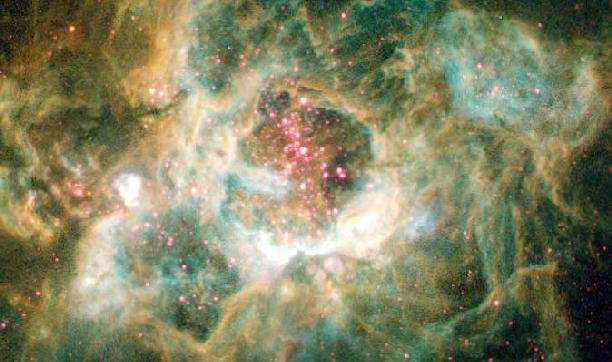
“Scattered within this cavernous nebula, cataloged as NGC 604, are over 200 newly formed hot, massive, stars. At 1,500 light-years across, this expansive cloud of interstellar gas and dust is effectively a giant stellar nursery located some three million light-years distant in the spiral galaxy, M33. The newborn stars irradiate the gas with energetic ultraviolet light stripping electrons from atoms and producing a characteristic nebular glow. The details of the nebula's structure hold clues to the mysteries of star formation and galaxy evolution."
Copyright: Public domain
#1028 Stars from Eagle's EGGs April 12, 1998
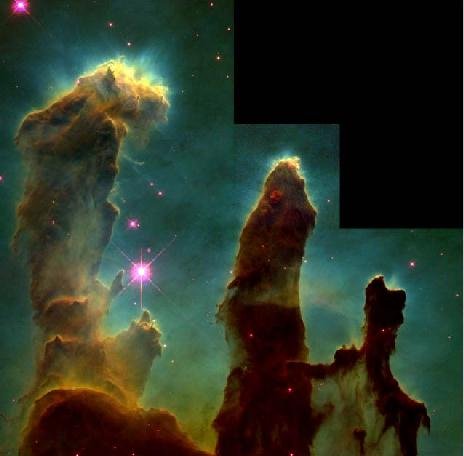
“Newborn stars are forming in the Eagle Nebula. This image, taken with the Hubble Space Telescope in 1995, shows evaporating gaseous globules (EGGs) emerging from pillars of molecular hydrogen gas and dust. The giant pillars are light years in length and are so dense that interior gas contracts gravitationally to form stars. At each pillars' end, the intense radiation of bright young stars causes low density material to boil away, leaving stellar nurseries of dense EGGs exposed. The Eagle Nebula, associated with the open star cluster M16, lies about 7000 light years away."
Copyright: Public domain
#1029 The Sun Changes April 13, 1998
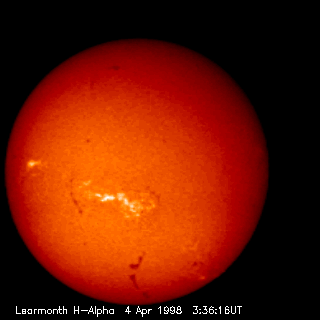
“Our Sun changes every day. This recent picture was taken in a very specific red color called Hydrogen-Alpha. Dark spots that might appear on the image are usually sunspots, dark magnetic depressions that are slightly cooler than the rest of the Sun's surface. Bright spots that might appear are usually plages, active regions that are slightly hotter than the rest of the Sun's surface. Over the next few years the average number of sunspots and plages will increase until "Solar Maximum" occurs in 2001. The Sun usually goes through a maximum and minimum every 11 years. From 1645 to 1715, however, almost no sunspots at all were recorded, for reasons unknown. (An updated picture can be found here.)"
Copyright: Public domain
#1030 Starlight Reflections April 14, 1998
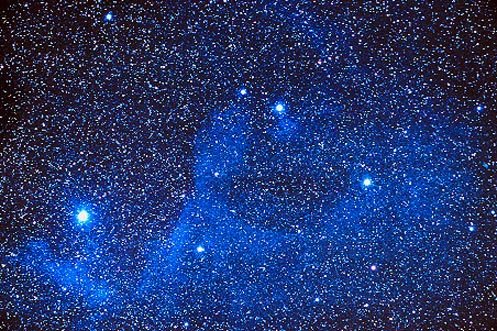
“Wisps of dust fill the space between the stars. This dust is usually invisible, subtly acting to dim the light of more distant stars. Sometimes this dust is thick and prominent as dark patches on otherwise bright emission nebulae. Other times this dust may show itself by reflecting the light of bright, nearby stars. Because bright stars tend to be blue, and because dust reflects blue light more easily than red, the resulting reflection nebula usually appears blue. Pictured above is the reflection nebula Sharpless 2-1 in the constellation of Scorpius."
Copyright: G. Greaney
#1031 NGC 1818: Pick A Star April 15, 1998
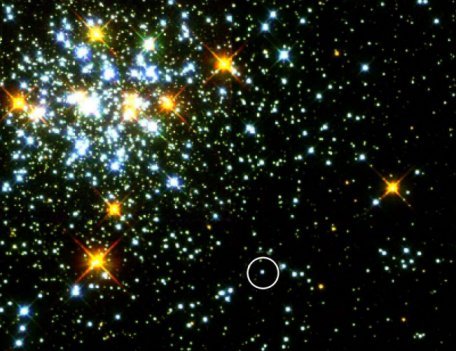
“This is NGC 1818, a youthful, glittering cluster of 20,000 stars residing in the Large Magellanic Cloud, 164,000 light-years away. Pick a star. Any star. Astronomers might pick the unassuming bluish-white one (circled) which appears to be a hot newly formed white dwarf star. What makes it so interesting? The standard astronomical wisdom suggests that stars over 5 times as massive as the sun rapidly exhaust their nuclear fuel and end their lives in a spectacular supernova explosion. With less than this critical mass they evolve into red giants, pass through a relatively peaceful planetary nebula phase, and calmly fade away as white dwarf stars like this one. Except that as a member of the NGC 1818 cluster, this new white dwarf would have evolved from a red giant star over 7.6 times as massive as the sun - which should have exploded! Its discovery will likely force astronomers to revise the limiting mass estimate for supernovae upward."
Copyright: Public domain
#1032 Mars: Cydonia Close-Up April 16, 1998
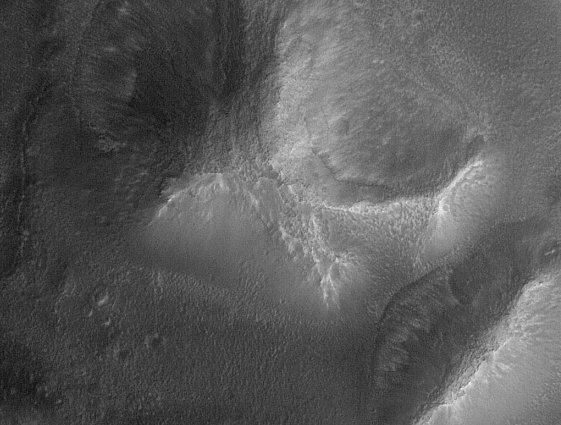
“The Mars Global Surveyor spacecraft has returned another close-up of the Cydonia region on Mars. Orbiting over clear Martian skies at a range of about 200 miles, the Mars Orbiter Camera looked down on features known as the "City" on Mars and produced a high resolution image covering a swath around 1.5 by 15 miles at a pixel size of about 8.2 feet. This cropped portion of the processed image shows an area approximately 1.5 miles wide. Heavily weathered hills and pocked surfaces suggest the erosion of layers of the ancient Martian crust."
Copyright: Public domain
#1033 Mars: Looking For Viking April 17, 1998
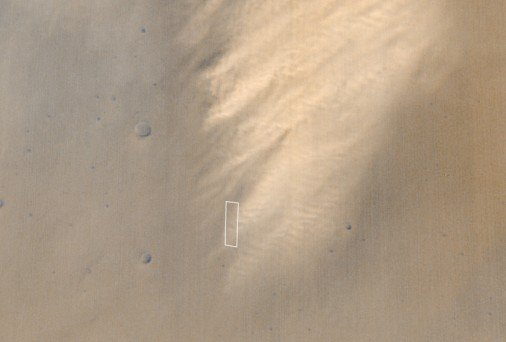
“On July 20, 1976, the Viking 1 lander touched down on the Martian Chryse Planitia. Its exact landing site is somewhere in the white rectangle above. Unfortunately, this wide angle Mars Global Surveyor image taken on April 12 reveals a substantial dust storm in the area with light colored plumes apparently blowing toward the upper right of the picture. Attempts to find the first spacecraft to land on Mars in the corresponding high resolution narrow field images have not been successful due in part to the increased atmospheric haze. The region shown here is about 100 miles across."
Copyright: Public domain
#1034 Star Wars in NGC 664 April 18, 1998
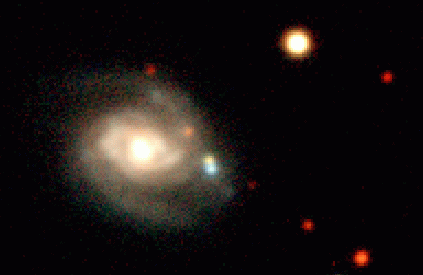
“Long ago in a galaxy far, far away, locked in their final desperate struggle against the force of gravity ... two stars exploded! stellar explosions - Supernovae - are among the most powerful events in the Universe, estimated to release an equivalent energy of up to 1 million trillion trillion (1 followed by 30 zeros) megatons of TNT. After the explosion, an expanding supernova envelope is observed to brighten over a a period of days to a maximum light output which rivals that of an entire galaxy before fading from view over the following months. Triggered by the collapsing core of a massive star or the nuclear demise of a white dwarf supernovae occur in average spiral galaxies only about once every 25-100 years. But a recent observation of NGC 664, a spiral galaxy about 300 million light years distant, captured a rare and colorful performance - two supernovae from the same galaxy. In this monitoring exposure the two supernovae, one reddish yellow and one blue, form a close pair just below the image center (to the right of the galaxy nucleus). The color difference is due to temperature - blue is hotter."
Copyright: Public domain
#1035 Betelgeuse April 19, 1998
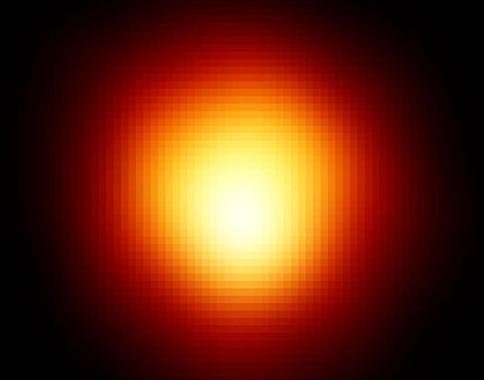
“Here is the first direct picture of the surface of a star other than our Sun. Taken by the Hubble Space Telescope in 1995, the atmosphere of Betelgeuse reveals some unexpected features, including a large bright hotspot visible below the center. Betelgeuse (sounds like "beetle juice") is a red supergiant star about 600 light years distant, easily recognizable from its brightness and reddish color in the constellation of Orion. While Betelgeuse is cooler than the Sun, it is more massive and over 1000 times larger. If placed at the center of our Solar System, it would extend past the orbit of Jupiter. Betelgeuse is nearing the end of its life and will become a supernova in a perhaps a few tens of millions of years."
Copyright: Public domain
Upvote! Resteem! Comment! As you like it! Thank you for attention!